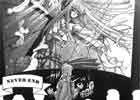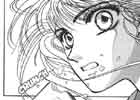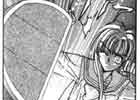Miyuki-chan in Wonderland
| Genre: Fantasy | ||
| Length: 1 Volume | ||
| Allegiance: Kadokawa Shoten/Tokyopop | ||
| Mangaka: Satsuki Igarashi, Mick Nekoi, Mokona Apapa, Nanase Ohkawa (CLAMP) | ||
| Vintage: 2003 | ||
| Intelligence Agency Report by: Zoomi | ||
| Your average schoolgirl Miyuki awakes to begin another normal day. Yet, as she heads off to school or work, she is transported to different worlds, which are very disturbing to her since every place is out of the ordinary. She wants nothing to do with them, but she winds up in these worlds, which vary from Lewis Carroll’s Alice in Wonderland to CLAMP’s X/1999, against her wishes. What can Miyuki do to stop these never ending hallucinations? | ||
|
|
||
| Research Agent Report by: Zoomi | ||
| Plot Characters Impact Visual |
7.00 6.00 8.00 8.00 |
|
| Overall | 7.50 | |
| (not an average) | ||
| When browsing through the bookshelves, anyone just introduced into the world of manga immediately focuses on CLAMP, well known for their creative stories and artistic style. That’s what I thought, when I was first introduced to manga, as I picked up Miyuki-chan in Wonderland. As I perused through the book, I was awestruck, for never had I expected anything like this to come from CLAMP. Same attention grabbing storyline, same artistic style, but the decision to place Miyuki-chan, a 16-year-old girl, in mature situations was a new concept, and ultimately, one that was too hard for me to justify.
Basically, our Miyuki-chan is taken to various worlds where she must overcome a problem in order to get home, whether it is to role play as a character or to call out a winning hand in mahjong. However, Miyuki is often intentionally placed in mature scenes during this process. In each world she enters, her clothes are ripped to shreds while women fondle over her for being so delicious. This overuse of fanservice just detracts from the already awkward and piecemeal story. Furthermore, the ending of each adventure is purposely left somewhat incomplete, with room for a continuation. This having been said, one would thinkMiyuki-chan in Wonderland would be a complete and fluid piece of work. However, the short stories are barely linked, and they are generally the same plot with different sceneries, so the whole storyline becomes repetitive. Yet CLAMP alleviates this somewhat and throws a bit of humor in the mix by putting their world from X/1999 in the manga; a delightful improvement. With this being such a short manga, there’s not much time for character development, yet we see Miyuki grow in strength amongst adversity. Even though she dislikes the positions she’s put in, you never see her break down and sob her heart out, begging for mommy. She never backs down from a challenge and has support from various characters to give her hope and to make her more determined. The trademark art style directly grabs your attention and transports you to the worlds that Miyuki sees. However, the art is too detailed for this short serial. CLAMP’s sense of detail and movement in character’s drawings clutter the page, often leaving you just the words to get the basic idea of the storyline. Whenever you go with Miyuki to a land and all you see are action lines and pictures of over-lusted females sporadically placed on the page, all you really can rely on is the dialogue. Despite this flaw, they make good use of common objects like mahjong, mirrors, and video games to give readers a look into their imagination; never would I think that limbs could extend from a TV or mirror and pull you in. Overall, Miyuki-chan in Wonderland is a great short story from CLAMP, and is the manifestation of a very different side of the famed studio. It may seem an unexpected story, but it’s still enjoyable for those open to various genres of manga.
|
||




